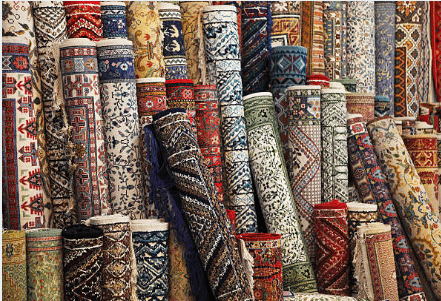Mixing and matching rugs in a single space can be a delightful way to add layers of texture, color, and warmth to your home. However, it requires a bit of finesse to ensure the rugs complement each other without overwhelming the room. In this blog, we'll share expert tips on how to master the art of mixing and matching rugs, helping you create a cohesive and visually appealing space.
Start with a Neutral Base

If you're new to mixing and matching rugs, starting with a neutral base can simplify the process. A large, neutral rug can act as a foundation, allowing you to introduce smaller, patterned or colorful rugs without clashing. Neutrals like beige, gray, or off-white create a serene backdrop that balances bolder designs.
Pro Tip: Choose a neutral rug with a subtle texture or pattern to add depth without stealing the spotlight from your accent rugs.
Play with Patterns

Patterns can add dynamic energy to a room but mixing them requires a careful eye. When combining patterned rugs, consider the following:
- Vary the Scale: Ensure the patterns are different in scale. For example, pair a rug with a large, bold pattern with one that has a smaller, more intricate design.
- Color Coordination: Stick to a cohesive color palette. Even if the patterns are different, similar colors will tie the look together.
- Balance Busy with Calm: If one rug has a busy pattern, balance it with a more subdued design to avoid overwhelming the space.
Pro Tip: Use one dominant pattern as the focal point and support it with secondary patterns that complement without competing.
Layering Rugs for Added Dimension

Layering rugs is a trend that adds dimension and richness to your decor. It works particularly well in large, open spaces where a single rug might feel lost. Here are some layering techniques to try:
- Base Layer: Start with a large, neutral rug as the base layer.
- Top Layer: Add a smaller, decorative rug on top. This could be a bold pattern, a pop of color, or a textured piece.
- Offset Layers: Try offsetting the top layer slightly for a more casual, laid-back look.
Pro Tip: Ensure the top rug is significantly smaller than the base rug to maintain a balanced and intentional appearance.
Consider Texture

Combining different textures can add tactile interest and depth to your space. For instance, mix a plush, high-pile rug with a flatweave or a jute rug. The contrast in textures will create a visually and physically engaging space.
Pro Tip: Ensure the textures are different enough to create contrast but still harmonious in style and feel.
Use Rugs to Define Zones

In open-plan spaces, rugs can be used to define different zones, such as the living area, dining area, or reading nook. Mixing and matching rugs in these spaces can help delineate each area while maintaining a cohesive flow.
- Living Area: Use a large, inviting rug to anchor the seating arrangement.
- Dining Area: A complementary rug under the dining table can distinguish the dining space.
- Accent Areas: Smaller, decorative rugs can highlight specific areas, like a reading corner or entryway.
Pro Tip: Ensure there's a visual connection between the rugs, whether through color, pattern, or texture, to maintain harmony in the space.
Experiment with Shapes

Don't be afraid to mix different shapes of rugs. A round rug can soften the angles of a rectangular room, while an irregularly shaped rug can add an unexpected twist. Combining different shapes can make the space more dynamic and interesting.
Pro Tip: When mixing shapes, ensure at least one common element (color, pattern, or style) ties them together to prevent a disjointed look.
Final Thoughts
Mixing and matching rugs is an art that, when done right, can elevate your interior decor to new heights. By starting with a neutral base, playing with patterns, layering, considering texture, defining zones, and experimenting with shapes, you can create a cohesive and stylish space that reflects your personality.
Remember, the key is to strike a balance between harmony and contrast. With these tips in mind, you'll be well on your way to mastering the art of mixing and matching rugs, transforming your home into a beautifully layered and inviting space. Happy decorating!

